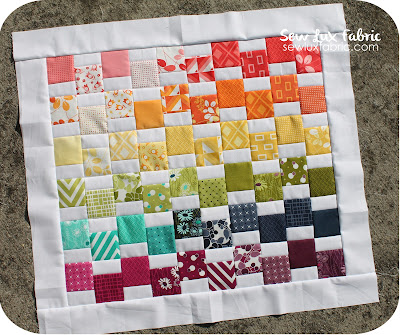Hi there!
I am finally back with the last block installment in this sampler project. This week, we are using the
Nantucket pattern. I've heard a few of you on Instagram share that this block is a little intimidating. And while it certainly does look difficult, you can totally do it! I photographed a few steps to share some tips with you all.
Before I go into the tips, I will say that this block is a little on the tedious side as you really need to pin carefully in each step. I would consider myself a confident piecer, so I didn't draw the lines as Camille suggests in the pattern. So, if this is a little scary, I would suggest you definitely do that AND maybe make a test 1/4 of a block to get more comfortable with this block.
First ... you are going to need some
pins! The finer the better.
I used pins in all the intersections as I pieced the strips and completed strip sets together. Put the pin through each unit at 1/4" and this will help line everything up nicely. (Remove pins as you sew!)
Side note: be really gentle when pinning ... you don't want to pull or tug the fabric a lot since there is a lot of bias going on here!
Continue pinning as you join the larger pieced triangle units into the quarter blocks. I used pins at every intersection as well as in the background triangles.
The pattern suggests that you may need to trim these quarter units. I chose to do so here. You can use the diagonal lines your mat if you have them to assist you, if needed. I didn't need to trim much ... especially in my 2nd and 3rd blocks where I was much more careful in handling and pressing my units.
Continue pinning when you join the quarter units together.
You'll make two halves of the block. And I pressed the seams between the quarter units in opposite directions so they would nest when I joined the two halves.
The next thing I want to share has to do with pressing ... and I mean "press" as opposed to "iron." All the block pieces have bias edges, which means that they will stretch. So you want to be very careful about pressing these blocks - in ALL stages of construction. Sometimes I "iron" and really force fabric where I need it to go. Here we want to press... so up and down (vertically) with the iron as opposed to doing more heavy-handed sliding of the iron on the seams, if that makes sense. I also chose not to use steam here to try and minimize stretching & distortion.
Another tip related to pressing is to finger press seams before you press them with the iron. I usually "set the seam" quickly with an iron and then gently press the seam open with my fingers before getting the iron involved. This just helps to make sure I don't work the fabric too hard with my iron.
(My good friend Lee at May Chappell calls this "married seams" in her glossary of important terms.)
Overall, I am happy with how these blocks turned out. They are not completely perfect, especially this first one that I made ....
You can see where I ended up trimming a little too much - which was possible because I had ironed a little more than I had pressed. :/
I will lose some points on the outer edge of my block. BUT ... in general, I think they turned out pretty good and this quilt is for me. Not for a show. But for me to enjoy and once it is quilted I don't think it will be super noticeable unless you really look. So I decided to live with it. :-)
I can't really decide which I like best. But I love the floral backgrounds. I specifically chose these for this block
in the kit because the seams would be less noticeable in the background.
Well, there you have them! Good luck! If you need help, just tag me on IG @sewlux and use #TBScrappySamplerQAL.
I will be back in a couple of days to share the layout process. We'll start in the middle and work our way out, so hang tight on that step!
Happy Sewing!





















































